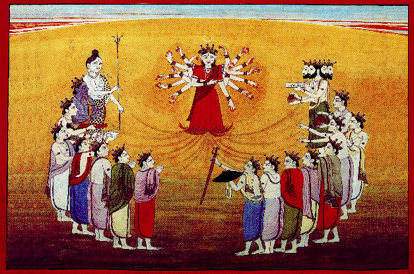
CHRISTOPHER JOHN DAVIES
"Hindu Female Deities as a
Resource for the Contemporary
Rediscovery of the Goddess"1 ,
and Beyond!
This article has arisen as a response to Rita Gross's provocative, "Hindu Female deities
as a Resource for the Contemporary Rediscovery of the Goddess"2. Gross proffer's a "second coming of the goddess"3, suggesting that we take seriously the task of installing workable goddess imagery
here in the west. How are we to do this? Gross discusses the problems contemporary
feminist theologians have come across when confronted with the task. Some feminists
have suggested that we look to personal experience, but as Gross notes, "We may simply
not have the experience to conjure up some of the most fruitful and compelling images of the goddess."4 As an alternative modality, other theologians have looked into our own Western
antiquity for images, "However, they are not with out problems, for they represent
a tiny inroad in a largely patriarchal tradition, or in the case of the ancient
goddesses, they are very removed from us."5 Gross, Recognizing the "problem of resources for goddess imagery"6 , suggests that we look to living goddess traditions. In particular she suggests
that we look to Hinduism. Gross argues that, "if approached critically and carefully,
and if intelligent selection and borrowing are utilized, the Hindu goddesses can
be the greatest stimulant to our imagination and to our speculation about the meaning
of the goddess."7
In this article I would like to build upon Gross's work
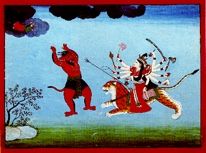
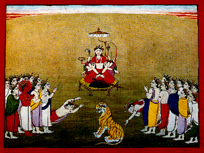 and offer some suggestions
for actualizing the resurgence of the goddess traditions here in the West. In considering
the task, there are two ideas which I think are central to our consideration:1) We must keep firmly in mind that the Hindu tradition which we are drawing from celebrates
"the goddess" as a variety of different goddesses. In some senses the idea of a
goddess, or "the goddess" as advanced by many contemporary feminist theologians,
is the unrecognized carry over of a monotheistic upbringing. What India has to offer us
is a variety of goddess traditions (plural). It is in fact this very plurality which
I think many persons find attractive, if one doesn't relate to Kali for example,
their are a variety of other goddesses to choose from. Keep "the goddess" flexible. We
are not simply trying to exchange a male imaged Judeo-Christian god for a female
imaged Judeo-Christian god, we are looking for a whole new paradigm altogether.
2) I might also suggest that the desire for a contemporary resurgence of the goddess traditions
here in the West, is not only a call for feminine imagery. I suggest that the cry
for "the goddess" is in fact a cry for polytheism, the way of our ancestors whom
"the goddess" has become a contemporary battle cry for. I think that people are not
only crying out for images of the divine female, but are both consciously and unconsciously
looking for ways to reimage "the god".
and offer some suggestions
for actualizing the resurgence of the goddess traditions here in the West. In considering
the task, there are two ideas which I think are central to our consideration:1) We must keep firmly in mind that the Hindu tradition which we are drawing from celebrates
"the goddess" as a variety of different goddesses. In some senses the idea of a
goddess, or "the goddess" as advanced by many contemporary feminist theologians,
is the unrecognized carry over of a monotheistic upbringing. What India has to offer us
is a variety of goddess traditions (plural). It is in fact this very plurality which
I think many persons find attractive, if one doesn't relate to Kali for example,
their are a variety of other goddesses to choose from. Keep "the goddess" flexible. We
are not simply trying to exchange a male imaged Judeo-Christian god for a female
imaged Judeo-Christian god, we are looking for a whole new paradigm altogether.
2) I might also suggest that the desire for a contemporary resurgence of the goddess traditions
here in the West, is not only a call for feminine imagery. I suggest that the cry
for "the goddess" is in fact a cry for polytheism, the way of our ancestors whom
"the goddess" has become a contemporary battle cry for. I think that people are not
only crying out for images of the divine female, but are both consciously and unconsciously
looking for ways to reimage "the god".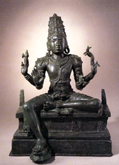 Judeo-Christian culture is not only responsible for suppressing images of the divine female, but is also responsible for limiting
images of the divine male. Realizing this, it is essential that in our enthusiasm
for the goddess we do not forget to attend to the highly unsatisfactory images of
"the god" given us in Judeo-Christian culture. We must be careful not to exchange
one limiting monotheism for another! Keep the Gods Flexible. From this point forward
in this article I will no longer use God or Goddess in the singular except when referring to a specific deity. In addition, I will write the plurals Gods, and Goddesses
with capital letters in order to accord these beings the same honor that the Judeo-Christian
God is normally accorded. It should be remembered that the word God is not a name but a designation like person or woman, therefore it is no more inappropriate
to capitalize Goddesses than it is to capitalize God.
Judeo-Christian culture is not only responsible for suppressing images of the divine female, but is also responsible for limiting
images of the divine male. Realizing this, it is essential that in our enthusiasm
for the goddess we do not forget to attend to the highly unsatisfactory images of
"the god" given us in Judeo-Christian culture. We must be careful not to exchange
one limiting monotheism for another! Keep the Gods Flexible. From this point forward
in this article I will no longer use God or Goddess in the singular except when referring to a specific deity. In addition, I will write the plurals Gods, and Goddesses
with capital letters in order to accord these beings the same honor that the Judeo-Christian
God is normally accorded. It should be remembered that the word God is not a name but a designation like person or woman, therefore it is no more inappropriate
to capitalize Goddesses than it is to capitalize God.
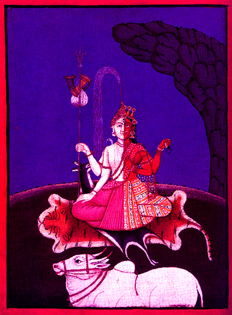
How do we begin to actualize the marvelous multiplicity of Gods and Goddesses available
to us? How can we best utilize Hindu Gods and Goddesses as a contemporary resource?
We must go beyond the image. It is not enough to simply imagine and to speculate about the meaning of a particular Goddess or God. The search for alternative mythologies
which has characterized the contemporary move towards a more inclusive and pluralistic
religious paradigm, can not generate by itself a new religious movement. The Gods must be met with and dialogued with on their own terms. What does this mean?
It means adopting traditional modes of Indian worship- learning puja (ritualized
offering to and propitiation of a deity). It means builiding temples to the Gods
and shrines in our homes. It means frequenting existing Hindu communities for guidance and
suggestions. Living traditions are not only important because they offer ideas which
others have found helpful, but also because living traditions carry the Sakti (power) of the deity. If a real resurgence of the Goddess traditions is to take place,
we must tap into this Sakti. Westerners must study Sanskrit, translate scriptures,
become proficient in ritual skills and teach their children to love, honor and respect
the Gods- to see the divine as immanent and available to those who sincerely seek
it. This is the foundation. From this foundation and with a solid basis in the
classical tradition from which we are presuming to draw upon (and only from this
basis), can we intelligently and critically generate contemporary and uniquely western idioms
through which to honor the Gods and Goddesses available to us. All of the greatest
artists had solid grounding in the classical tradition before breaking away to create
new and interesting genres and interpretations of traditional materials. Picasso could
paint like an old master before he ever attempted Guernica. Martha Graham developed
her extraoridinary dance technique on the basis of an extremely rigorous ballet training. I am suggesting that "the second coming of the goddess"8 is going to require artisans of no less skill. Before attempting to break away
from existing traditions we must know what it is we are breaking away from. We might
find that there is less to discard than we thought, and more to discover within
the classical Indian tradition than we ever imagined. We must however be disciplined.
Institutes of Vedic Studies should be established around the country for the education
of our people. Scholars and holy persons should travel to India and take initiations
bringing important lineages back to our shores. In the mean time flood your local
Hindu temples, frequent your local Indian communities and learn, learn everything
you can. We have at least 2,000 years of lost time to make up for. Goddess willing,
Sanatana Dharma (the eternal way) will be established on our shores in our very lives!
Victory to the Mother!
Footnotes
1"Rita M. Gross, "Hindu Female Deities as a Resource for the Contemporary Rediscovery of the Goddess," in The Book of the Goddess, ed. Carl Olson (New York: Crossroad, 1990 c1983), 217."
2Ibid.
3Ibid.
4Ibid., 218.
5Ibid., 218.
6Ibid., 217.
7Ibid., 218.
8Ibid., 217.
Visit some resources on the Goddess (and God).



 and offer some suggestions
for actualizing the resurgence of the goddess traditions here in the West. In considering
the task, there are two ideas which I think are central to our consideration:1) We must keep firmly in mind that the Hindu tradition which we are drawing from celebrates
"the goddess" as a variety of different goddesses. In some senses the idea of a
goddess, or "the goddess" as advanced by many contemporary feminist theologians,
is the unrecognized carry over of a monotheistic upbringing. What India has to offer us
is a variety of goddess traditions (plural). It is in fact this very plurality which
I think many persons find attractive, if one doesn't relate to Kali for example,
their are a variety of other goddesses to choose from. Keep "the goddess" flexible. We
are not simply trying to exchange a male imaged Judeo-Christian god for a female
imaged Judeo-Christian god, we are looking for a whole new paradigm altogether.
2) I might also suggest that the desire for a contemporary resurgence of the goddess traditions
here in the West, is not only a call for feminine imagery. I suggest that the cry
for "the goddess" is in fact a cry for polytheism, the way of our ancestors whom
"the goddess" has become a contemporary battle cry for. I think that people are not
only crying out for images of the divine female, but are both consciously and unconsciously
looking for ways to reimage "the god".
and offer some suggestions
for actualizing the resurgence of the goddess traditions here in the West. In considering
the task, there are two ideas which I think are central to our consideration:1) We must keep firmly in mind that the Hindu tradition which we are drawing from celebrates
"the goddess" as a variety of different goddesses. In some senses the idea of a
goddess, or "the goddess" as advanced by many contemporary feminist theologians,
is the unrecognized carry over of a monotheistic upbringing. What India has to offer us
is a variety of goddess traditions (plural). It is in fact this very plurality which
I think many persons find attractive, if one doesn't relate to Kali for example,
their are a variety of other goddesses to choose from. Keep "the goddess" flexible. We
are not simply trying to exchange a male imaged Judeo-Christian god for a female
imaged Judeo-Christian god, we are looking for a whole new paradigm altogether.
2) I might also suggest that the desire for a contemporary resurgence of the goddess traditions
here in the West, is not only a call for feminine imagery. I suggest that the cry
for "the goddess" is in fact a cry for polytheism, the way of our ancestors whom
"the goddess" has become a contemporary battle cry for. I think that people are not
only crying out for images of the divine female, but are both consciously and unconsciously
looking for ways to reimage "the god". Judeo-Christian culture is not only responsible for suppressing images of the divine female, but is also responsible for limiting
images of the divine male. Realizing this, it is essential that in our enthusiasm
for the goddess we do not forget to attend to the highly unsatisfactory images of
"the god" given us in Judeo-Christian culture. We must be careful not to exchange
one limiting monotheism for another! Keep the Gods Flexible. From this point forward
in this article I will no longer use God or Goddess in the singular except when referring to a specific deity. In addition, I will write the plurals Gods, and Goddesses
with capital letters in order to accord these beings the same honor that the Judeo-Christian
God is normally accorded. It should be remembered that the word God is not a name but a designation like person or woman, therefore it is no more inappropriate
to capitalize Goddesses than it is to capitalize God.
Judeo-Christian culture is not only responsible for suppressing images of the divine female, but is also responsible for limiting
images of the divine male. Realizing this, it is essential that in our enthusiasm
for the goddess we do not forget to attend to the highly unsatisfactory images of
"the god" given us in Judeo-Christian culture. We must be careful not to exchange
one limiting monotheism for another! Keep the Gods Flexible. From this point forward
in this article I will no longer use God or Goddess in the singular except when referring to a specific deity. In addition, I will write the plurals Gods, and Goddesses
with capital letters in order to accord these beings the same honor that the Judeo-Christian
God is normally accorded. It should be remembered that the word God is not a name but a designation like person or woman, therefore it is no more inappropriate
to capitalize Goddesses than it is to capitalize God.